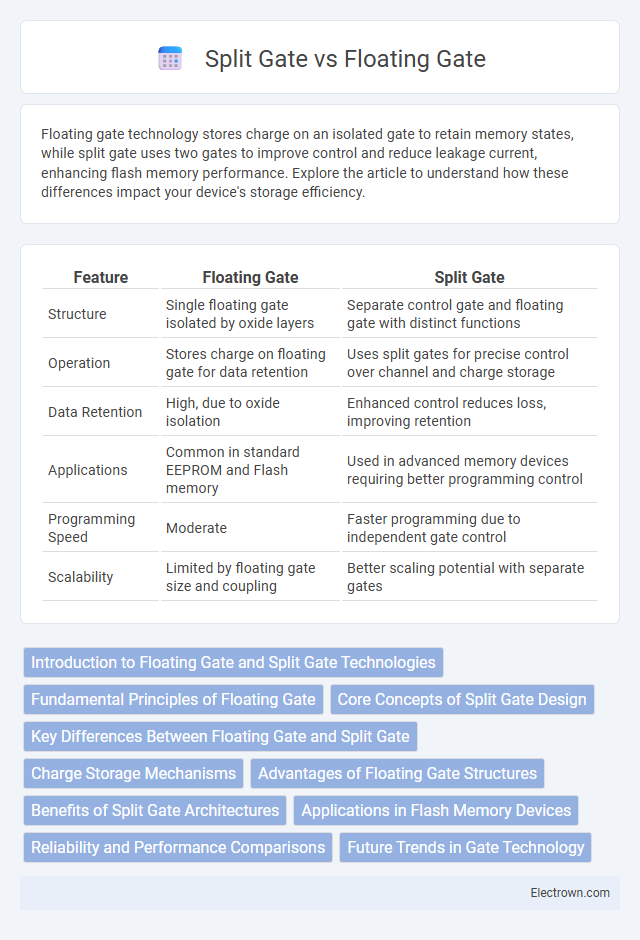Floating gate technology stores charge on an isolated gate to retain memory states, while split gate uses two gates to improve control and reduce leakage current, enhancing flash memory performance. Explore the article to understand how these differences impact your device's storage efficiency.
Table of Comparison
| Feature | Floating Gate | Split Gate |
|---|---|---|
| Structure | Single floating gate isolated by oxide layers | Separate control gate and floating gate with distinct functions |
| Operation | Stores charge on floating gate for data retention | Uses split gates for precise control over channel and charge storage |
| Data Retention | High, due to oxide isolation | Enhanced control reduces loss, improving retention |
| Applications | Common in standard EEPROM and Flash memory | Used in advanced memory devices requiring better programming control |
| Programming Speed | Moderate | Faster programming due to independent gate control |
| Scalability | Limited by floating gate size and coupling | Better scaling potential with separate gates |
Introduction to Floating Gate and Split Gate Technologies
Floating gate technology uses a conductive gate isolated by oxide layers to trap and store charge, enabling non-volatile memory retention. Split gate devices feature two gates that separately control the channel, allowing improved charge control and reduced interference. Your choice between floating gate and split gate technologies depends on desired memory performance, endurance, and scalability requirements.
Fundamental Principles of Floating Gate
The floating gate transistor operates by storing electrical charge on a polysilicon gate insulated by an oxide layer, allowing it to retain data without power. This stored charge alters the threshold voltage of the transistor, enabling non-volatile memory functions crucial for Flash memory devices. In contrast, the split gate design separates the control gate from the floating gate, enhancing programming efficiency but fundamentally relies on the charge storage principle of the floating gate.
Core Concepts of Split Gate Design
Split gate design in memory devices features two separate gates controlling a floating gate, enhancing charge storage precision and reducing interference. This architecture improves programming and erasing speeds by isolating control and select gates, allowing more efficient charge injection and removal. The core concept relies on spatial separation to optimize electrical field distribution, thereby increasing device reliability and endurance in non-volatile memory applications.
Key Differences Between Floating Gate and Split Gate
The key differences between floating gate and split gate memory cells lie in their architecture and charge storage mechanisms. Floating gate cells use a single gate structure entirely surrounded by an oxide layer to trap charges, enabling non-volatile data storage, whereas split gate cells separate the control gate and floating gate, enhancing programming efficiency and reducing disturb errors. Split gate designs typically offer improved endurance and faster programming speeds compared to traditional floating gate memory.
Charge Storage Mechanisms
Floating gate memory stores charge by trapping electrons in a conductive floating gate insulated by a thin oxide layer, enabling non-volatile data retention through charge retention within the isolated gate. Split gate memory divides the floating gate into two sections, separating the control and storage regions to minimize charge leakage and improve program/erase endurance by localizing electron storage. This architectural difference enhances reliability and performance in split gate devices by optimizing electron tunneling paths and charge injection control.
Advantages of Floating Gate Structures
Floating gate structures offer significant advantages in non-volatile memory applications due to their superior charge retention and high endurance. These structures enable efficient programming and erasing cycles, supporting reliable long-term data storage compared to split gate designs. Your devices benefit from enhanced data integrity and reduced leakage currents, making floating gate technology ideal for flash memory cells.
Benefits of Split Gate Architectures
Split gate architectures enhance memory cell performance by providing better control over the channel, reducing leakage current and improving data retention compared to floating gate designs. They offer greater scalability and reliability due to their precise threshold voltage modulation, which benefits advanced non-volatile memory applications. Your devices can achieve higher endurance and faster program/erase cycles, making split gate technology ideal for modern flash memory solutions.
Applications in Flash Memory Devices
Floating gate technology is widely used in NAND and NOR flash memory devices due to its ability to store multiple bits per cell, enhancing data density and cost efficiency for consumer electronics and storage applications. Split gate memory devices offer improved endurance and high program/erase speed, making them suitable for embedded applications where reliability and fast access are critical. Both technologies play crucial roles in the development of non-volatile memory solutions, with floating gate dominating mass storage and split gate targeting specialized, high-performance environments.
Reliability and Performance Comparisons
Floating gate memory cells offer high data retention and endurance due to their robust charge storage mechanism, making them reliable for long-term applications. Split gate cells enhance performance by reducing leakage currents and enabling faster programming speeds through separated control and tunneling gates. The choice between floating gate and split gate architectures depends on specific requirements for data integrity, speed, and endurance in non-volatile memory applications.
Future Trends in Gate Technology
Emerging trends in gate technology highlight the shift from traditional floating gate designs to advanced split gate architectures, driven by scaling challenges and reliability improvements. Split gate technology offers enhanced charge retention and reduced interference, making it favorable for next-generation non-volatile memory applications like 3D NAND and embedded flash. Future developments will focus on integrating split gate structures with novel materials and 3D stacking techniques to further boost density, endurance, and power efficiency in semiconductor devices.
Floating gate vs split gate Infographic

 electrown.com
electrown.com